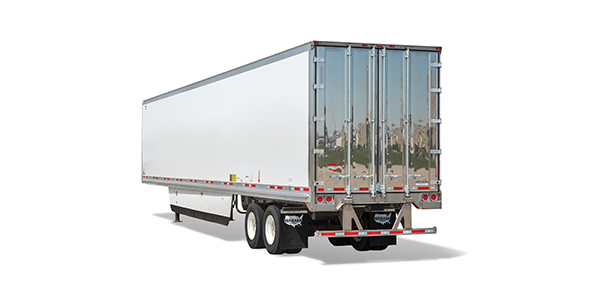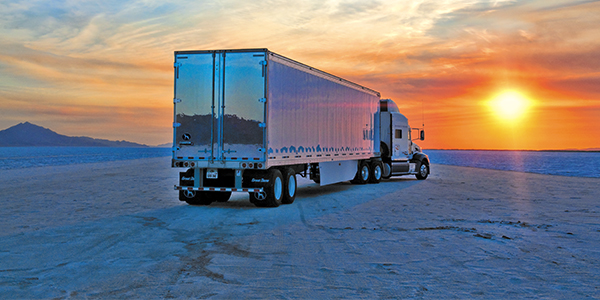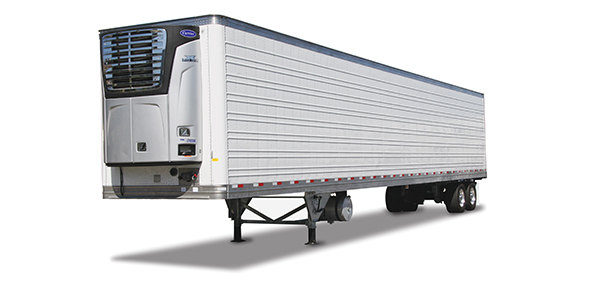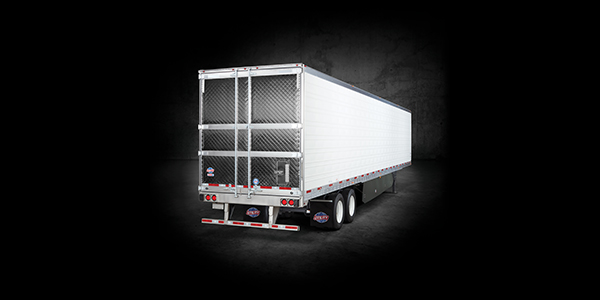“Moisture intrusion in refrigerated trailers impacts thermal performance through the degradation of insulating foam quality, increases in thermal conductivity and potential weight gain,” says Chris Lee, vice president of engineering at Great Dane Trailers. “Outgassing, in particular, causes moisture intrusion into foam cells, degrading the insulation’s value and leading to as much as a 30% to 40% loss of thermal efficiency throughout the life of trailer.
“While fuel economy in refrigerated trailers depends heavily on operating conditions, including travel distances, temperature range and frequency of door opening and closing events, moisture intrusion can worsen losses even more,” Lee adds. “One independent study showed that fuel loss can vary from several hundreds to more than a thousand gallons within five years of operation when moisture intrusion conditions are present. In addition, maintenance costs can be higher since moisture intrusion accelerates trailer aging.”
Adam Hill, vice president of technical sales and warranty at Hyundai Translead, points out that it is natural to lose thermal efficiency in a refrigerated trailer over time as insulating gasses inside the foam insulation structure are replaced with atmospheric air. “Over the life of the vehicle, this can mean 30% less efficiency because air is not as thermally resistant as insulating gasses,” he relates.
“On a larger scale, the ability of water to conduct heat is much higher than the urethane foams used in refrigerated vehicles,” Hill continues. “Depending on the chemical components of gases used in blown urethane, heat transfer through water into a cooled trailer interior water can be 25 to 30 times faster.”
Cuts and openings in the wear band and interior lining and ceiling, as well as gouges in the floor are the main points of moisture intrusion in refrigerated trailers, notes Craig Bennett, senior vice president of sales and marketing at Utility Trailer Manufacturing Co. “Also, trailers that do not have inherently water tight interiors will leak moisture into the foam,” he says. “The result is premature foam insulation degradation and loss of thermal efficiency, as well as weight gain leading to less payload capacity.”
According to Great Dane’s Lee, connection areas around a trailer’s structural members are most susceptible to moisture intrusion. That includes where walls meet front and rear corners, the top rail to roof connection, around the mounting frame for the refrigeration unit, floor to wall mating surfaces, surrounding fasteners and at door gaskets.
There are several points of moisture intrusion, notes Hyundai Translead’s Hill. “Sidewall panels must be fastened together mechanically so OEMs have the challenge of employing designs that keep moisture out of the areas where panels are joined,” he says. “While mechanically fastened designs allow for more efficient repairs and better durability, the manufacturing process may require blind fasteners because only one side of an assembly is accessible, and those fasteners do not offer the same moisture protection.”
New designs
While moisture intrusion is an ongoing challenge, trailer manufacturers are finding ways to prevent the loss of thermal efficiency in refrigerated models. One area of focus, as environmental regulations have influenced the chemical components of insulating materials, has been on using new designs to enhance performance.
“Continuous testing and research efforts have been put in place to help improve foam blowing agents for both environmental protection and to maintain insulating values,” Great Dane’s Lee says. “The California Air Resources Board (CARB) and Canada will be putting new mandates in effect starting in 2020.
“Today, we are already seeing the development and use of composite materials to replace wood and thermally conductive metal for frames and panels,” Lee adds. “Fleets can also spec non-wood construction in trailer walls and floors to significantly reduce moisture intrusion.”
A design process focused on meeting several goals for deterring moisture intrusion and increasing thermal efficiency is in place at Hyundai Translead, Hill notes. Among the solutions the manufacturer has deployed are to replace wood stringers and furring spacers with composite structures that do not absorb the moisture that typically migrates through exposed fasteners holding them in position.
“We are also replacing traditional fasteners with adhesive technologies or design alternatives that do not depend on sealants or caulking to keep water at bay, but use them only as added insurance,” Hill points out. “In areas most vulnerable to moisture intrusion, such as floor joints, we’re using aluminum welding technology that provides for greater integrity so cracks don’t develop and allow moisture to penetrate substructures. In addition, joints that were once lapped now have a tongue-and-grove design that hinders moisture intrusion into foam cavities.”
While the EPA is going to be requiring a new foam formulation that may enhance moisture resistance, Utility’s Bennett points out that a completely watertight design is already an approach the manufacturer takes for its refrigerated trailer models. Included are a welded floor and wear band system, virtually no interior rivets to break off and provide leak points, dual durometer door seals with additional wiper gaskets and a one-piece underskin to seal out road spray. “Maintenance, including repairing cuts promptly, is also extremely important for keeping the inside of the trailer and the outside walls and underskin totally sealed,” he adds.
To address moisture intrusion throughout the life of Great Dane Everest refrigerated trailers, the manufacturer has developed a liner material with a non-permeable barrier. The ThermoGuard fiberglass-reinforced, thermoplastic liner made for the OEM’s refrigerated models features a metal barrier layer that effectively seals the trailer’s insulation from the harmful effects of outgassing, water vapor and outside air absorption.
Great Dane ThermoGuard liners significantly reduce insulation degradation caused by normal aging in trailers as compared to trailers with traditional interior linings, Lee notes. “With ThermoGuard, cooling units don’t have to work as hard to make up for degrading insulation performance, reducing cooling unit run-time, saving fuel and refueling time, extending refrigeration unit life and lowering maintenance costs over the life of the trailer,” he says.
New moisture prevention features can now be found in Hyundai Translead refrigerated trailers, Hill relates. Included in the manufacturer’s product line are the ThermoTech MC (Maximum Cubic), ThermoTech TL for truckload carriers and ThermoTech SP for grocery, dairy and food distribution markets.
Utility offers the 3000R and 3000R multi-temp refrigerated models built with foam-in-place insulation with no joints to improve thermal efficiency, and with a low conduction barrier between the threshold and buckplate to reduce heat transfer. The manufacturer also offers a rear Barrier Door with a bonded foam sandwich design that it says improves thermal performance by using external hat sections to mount all door hardware without drilling holes into the foam cavity.
Utility refrigerated trailer models are also available with the OEM’s Versitex-Utility VR2 lining on the interior walls and on the lower sub‑pan below the floor to help keep the foam insulation dry and reduce overall heat loss.
Wabash National’s Cold Chain composite reefer is constructed with its Molded Structural Composite (MSC) technology for floors, roofs and walls, which the manufacturer says is 25% more thermally efficient than other designs. MSC uses a foam core encapsulated in a polymer fiber-reinforced shell and a protective gel coat to protect against water intrusion and foam degradation. Wabash also offers ArcticLite refrigerated trailers featuring sidewalls with thermal breaks to prevent heat transfer.
The Kidron G2 refrigerated trailer, according to the manufacturer, has thermally efficient side walls due to the use of its ColdShield temperature management technology. The system includes high pressure impingement mixing for insulating foam and foam-dam technology that eliminates migration.
Refrigeration unit efficiency
A key factor in offsetting potential losses in thermal efficiency in refrigerated trailers are units that are up to the challenge of effectively providing cooling capacity.
“It’s important for trailer refrigeration units to have the capacity to not only meet the anticipated required demand, but also offer some excess capacity in anticipation of diminished thermal performance over time,” says Patrick McDonald, product manager for trailer products at Carrier Transicold, Truck/Trailer/Rail Americas.
“The appropriate trailer for one fleet application is likely different than one for another application,” says Tom Kampf, product manager at Thermo King North America. “A transport refrigeration unit that offers flexibility is paramount when selecting equipment.”
To match the right trailer and appropriate refrigeration unit, Kampf advises fleets to strike a balance between efficiency and cost, and to consider solutions that support a wide range of refrigerated applications.
“For example, a fleet may elect to purchase a moderately efficient trailer with a high-capacity refrigeration unit,” he relates. “The benefit of this scenario is more flexibility in load profiles. More room and less weight on the trailer can be valuable as long as the refrigeration unit provides the flexibility to transport a variety of goods.”
As more fleets adopt electric standby systems for use when refrigerated trailers are stationary, Carrier Transicold’s McDonald says it is critical to correctly specify equipment for that application as well. “Arguably, the demand for performance may be even greater when a trailer refrigeration unit is plugged into standby power,” he says. “Fleets planning to use electric standby should make sure the unit has electric standby capacity equal to the capacity offered by the diesel engine.”
Carrier Transicold’s Vector trailer refrigeration units, with built-in electric standby, provide 100% of the unit’s rated refrigeration capacity when plugged into a power source, McDonald notes. “That is an important consideration when understanding that performance will be especially important as the trailer’s thermal efficiency wanes over time,” he says.
Carrier Transicold also offers the belt-driven X4 Series Model 7300 unit which, at 66,000 BTU/hour of cooling, has one of today’s highest trailer refrigeration capacities, according to McDonald. The unit also has three to 10% greater capacity than Carrier Transicold models sold five years ago, providing greater cooling with less fuel consumption, McDonald adds.
Available from Thermo King is the Precedent line of trailer refrigeration units. The platform utilizes Diesel Direct Electric (DDE) architecture, which according to Kampf combines the best of diesel-electrical and diesel-mechanical designs to ensure minimal loss of thermal efficiency and to maximize fuel efficiency.
















